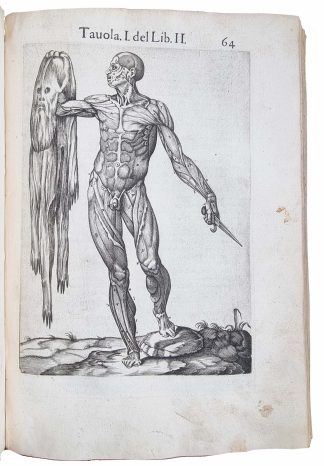VALVERDE DE HAMUSCO, Juan de.
FINE ANATOMICAL ENGRAVINGS
Anatomia del corpo umano.
Rome, A. Salamanca and A. Lafreri, 1560.£9,750.00
FIRST EDITION thus. Folio. ff. [18], 154. Roman letter, little Italic. Engraved architectural title with skeletons, monkey, pig and scenes from anatomical lectures, 42 full-page anatomical engravings by N. Beatrizet after G. Becerra, handful of small woodcuts of blood vessels, decorated initials and ornaments. Intermittent very light water stain along upper blank margin slightly more noticeable in couple of gatherings, few ll. very slightly browned, a little mostly marginal finger- or ink-soiling. A very good copy, on thick high-quality paper, in contemporary Spanish limp vellum, lacking ties, recased, very minor repair to extremities, contemporary ms title to spine (faded), C18 bookplate of Juan Pignatelli Fernández de Heredia (1724-76), Conde de Fuentes, to title verso. In folding box.
A very good well-margined copy of the first edition in Italian of this important study of human anatomy, with 42 fine, full-page engravings. Juan de Valverde de Hamusco (c.1525-?) studied medicine at Padua and Rome under Realdo Columbo and Bartolomeo Eustachi. Originally published in Castilian as ‘Historia de la composicion del cuerpo humano’ (Rome, 1556), ‘Anatomia’ was translated into Italian by Anton Tabo, under Valverde’s supervision. A Latin translation only followed much later, which suggests the original intended audience were mainly barber-surgeons, who generally did not possess a sound knowledge of Latin. Dedicated to King Philip II, ‘Anatomia’ is divided into 7 books. The first part of each is a textual study, the second a collection of engraved plates with facing explanatory tables. Book I deals with bones, head to foot, and their structure, as well as of teeth, nails, cartilage of the nose and ears, and the throat. Book II focuses on muscles, the skin and ligaments; Book III on the digestive and reproductive system; Book IV on the ‘organs of life’ (i.e., heart, lungs); Book V on the brain; Book VI on blood vessels, and Book VII on the nerves.
Based on the famous woodcuts in Vesalius’ ‘Humani corporis fabrica’, the 42 engravings include 4 that are original to Valverde’s work. In general, ‘we find several figures which do not occur in Vesalius’ works, e.g., a muscle-manikin holding his skin in his right hand and a dagger in his left; several representations of the abdominal muscles, of the momentum and the intestines; a standing pregnant woman with her abdomen cut open, and representations of the principal veins and many others. Parts of the bodies are dressed in armor’ (Choulant, p.205). The ‘muscle-manikin’ holding his skin bears a striking resemblance to Michelangelo’s St Bartholomew (both Beatrizet and Becerra were associated with him) depicted in the Sistine Chapel. A plate in Book IV shows the anatomist at work, as he delves into the open chest of a corpse; the anatomist himself is shown in anatomical layers, his lungs in full view. Valverde was accused of plagiarising Vesalius; he replied he had decided not to make new anatomical figures, replicating Vesalius’ instead, so his readers would see more easily, from the occasional differences to the original, what Valverde disagreed on.
USTC 861981; EDIT16 CNCE 48221; Durling 4532; Osler 576 (1586 ed.); Heirs of Hippocrates (1586 ed.); Choulant-Frank, pp.205-7; Wellcome 6476.In stock






